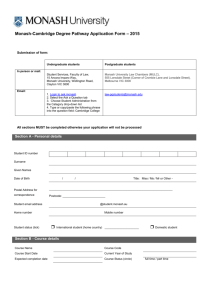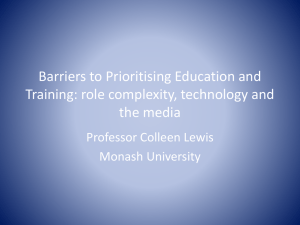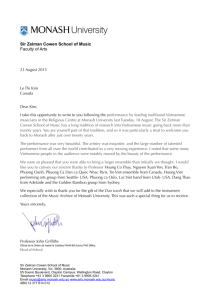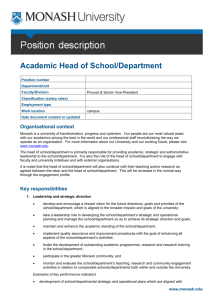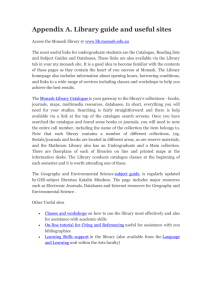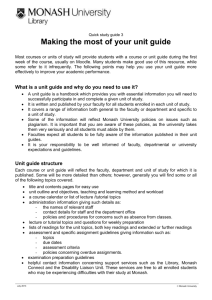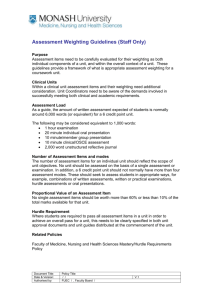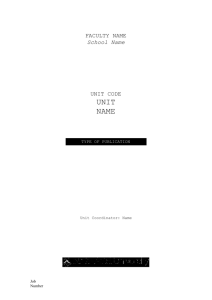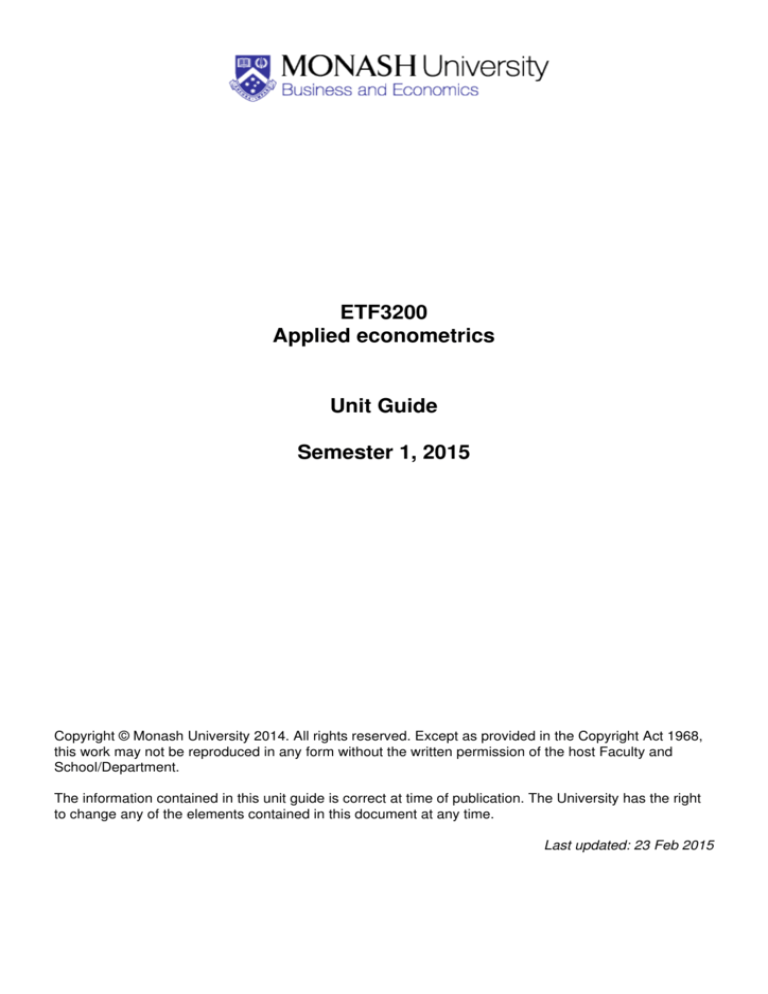
ETF3200
Applied econometrics
Unit Guide
Semester 1, 2015
Copyright © Monash University 2014. All rights reserved. Except as provided in the Copyright Act 1968,
this work may not be reproduced in any form without the written permission of the host Faculty and
School/Department.
The information contained in this unit guide is correct at time of publication. The University has the right
to change any of the elements contained in this document at any time.
Last updated: 23 Feb 2015
Table of Contents
ETF3200 Applied econometrics - Semester 1, 2015...............................................................................1
Mode of Delivery..............................................................................................................................1
Workload requirements....................................................................................................................1
Additional workload requirements........................................................................................1
Unit Relationships........................................................................................................................................1
Prerequisites....................................................................................................................................1
Prohibitions......................................................................................................................................1
Chief Examiner(s)........................................................................................................................................1
Campus Lecturer(s).....................................................................................................................................2
Caulfield...........................................................................................................................................2
Tutor(s)........................................................................................................................................................2
Caulfield...........................................................................................................................................2
Your feedback to Us....................................................................................................................................2
Previous Student Evaluations of this Unit....................................................................................................2
Academic Overview...................................................................................................................................3
Learning Outcomes.........................................................................................................................3
Unit Schedule.............................................................................................................................................4
Teaching Approach..........................................................................................................................4
Assessment Summary.....................................................................................................................4
Hurdle Requirements...........................................................................................................5
Second marking...................................................................................................................5
Return of final marks............................................................................................................5
Assessment criteria..............................................................................................................5
Assessment Requirements......................................................................................................................6
Assessment Tasks...........................................................................................................................6
Assessment task 1...............................................................................................................6
Assessment task 2...............................................................................................................6
Assessment task 3...............................................................................................................7
Examination(s).............................................................................................................................................7
Examination 1..................................................................................................................................7
Learning resources......................................................................................................................................7
Feedback to you..........................................................................................................................................8
Assignment submission...............................................................................................................................8
Online submission...........................................................................................................................8
Prescribed text(s) and readings.......................................................................................................8
Recommended Resources..........................................................................................................................8
Recommended text(s) and readings................................................................................................8
Other Information....................................................................................................................................10
Policies..........................................................................................................................................10
Graduate Attributes Policy.................................................................................................10
Student Charter.........................................................................................................................................10
Student services........................................................................................................................................10
Monash University Library.........................................................................................................................10
Moodle 2....................................................................................................................................................10
Disability Liaison Unit................................................................................................................................11
ETF3200 Applied econometrics - Semester 1, 2015
This unit presents econometric models and techniques that are widely used in applied econometrics. The
topics covered are linear regression models with random regressors, method of moments and
instrumental variables estimation; simultaneous equations models; models for time-series data;
introduction to maximum likelihood estimation; models for discrete dependent variables and models for
panel data. EViews computer software is used to carry out data analysis and estimation.
Mode of Delivery
Caulfield (Day)
Workload requirements
Minimum total expected workload to achieve the learning outcomes for this unit is 144 hours per
semester typically comprising a mixture of scheduled learning activities and independent study.
Independent study may include associated readings, assessment and preparation for scheduled
activities. The unit requires on average three/four hours of scheduled activities per week. Scheduled
activities may include a combination of teacher directed learning, peer directed learning and online
engagement.
See also Unit timetable information
Additional workload requirements
This is a six credit point unit with three hours class contact per week over 12 teaching weeks. In order to
meet the faculty’s expectation, students should plan to spend on average eight hours in self-directed
study, in addition to the three hours of class contact, each week.
Unit Relationships
Prerequisites
Students must have passed ETF2100 or ETC2410 or ETC3440 or equivalent or must be enrolled in
Course Code 3822 or 4412.
Prohibitions
ETC3410
Chief Examiner(s)
Dr Vasilis Sarafidis
1
ETF3200 Applied econometrics - Semester 1, 2015
Campus Lecturer(s)
Caulfield
Dr Vasilis Sarafidis
Campus: Caulfield
Phone: +61 3 990 32179
Email: Vasilis.Sarafidis@monash.edu
Contact hours: Monday 3-5 pm, H5.68
Tutor(s)
Caulfield
Dr Ari Handayani
Campus: Caulfield
Phone: +61 3 990 34349
Email: Ari.Handayani@monash.edu
Contact hours: 2:30-3:30 pm; H4.76
Your feedback to Us
Monash is committed to excellence in education and regularly seeks feedback from students, employers
and staff. One of the key formal ways students have to provide feedback is through the Student
Evaluation of Teaching and Units (SETU) survey. The University’s student evaluation policy requires that
every unit is evaluated each year. Students are strongly encouraged to complete the surveys. The
feedback is anonymous and provides the Faculty with evidence of aspects that students are satisfied
and areas for improvement.
For more information on Monash’s educational strategy, see:
www.monash.edu.au/about/monash-directions/ and on student evaluations, see:
www.policy.monash.edu/policy-bank/academic/education/quality/student-evaluation-policy.html
Previous Student Evaluations of this Unit
Some material has been removed to place emphasis on most important stuff.
Previous student feedback has highlighted that the course content is presented well and the teaching
style is engaging.
If you wish to view how previous students rated this unit, please go to
https://emuapps.monash.edu.au/unitevaluations/index.jsp
2
Academic Overview
Learning Outcomes
The learning goals associated with this unit are to:
1. conduct statistical inference in linear regression models with random regressors using the
method of moments and the instrumental variables estimators
2. conduct statistical inference for simultaneous equations models
3. understand the statistical properties of nonstationary macroeconomic time series data and how to
model the long-run relationships among co-integrated time series
4. conduct statistical inference in models with discrete dependent variables
5. conduct statistical inference in panel data models.
3
Unit Schedule
Week
Activities
Assessment
0
No formal assessment or activities are
undertaken in week 0
1
Review of Regression and Regression in Matrix
Notation
2
Random Regressors/Moment-Based Estimation
3
Random Regressors/Simultaneous Equations Models
4
Simultaneous Equations Models
5
The Concept of Non-Stationarity - Testing for Unit
Roots
6
Error Correction Models
7
Cointegration
8
VEC and VAR Models
9
Panel Data Analysis
10
Panel Data Analysis
11
Dynamic Panel Data Models
12
Revision
Assignment 3 due Friday (17:00 in
Vasilis' mailbox)
SWOT VAC
No formal assessment is undertaken
SWOT VAC
Examination period
LINK to Assessment Policy:
http://policy.monash.edu.au/policy-bank/
academic/education/assessment/
assessment-in-coursework-policy.html
Assignment 1 due Monday (12:00 in
lecture)
Assignment 2 due Monday (12:00 in
lecture)
Teaching Approach
Lecture and tutorials or problem classes
"This teaching and learning approach provides facilitated learning, practical exploration and peer
learning."
Assessment Summary
Within semester assessment: 40%
Examination: 60%
Assessment Task Value
Due Date
Assignment 1
10%
Week 5 Monday by 12:00 at the beginning of the lecture
Assignment 2
15%
Week 10 Monday by 12:00 at the beginning of the lecture
Assignment 3
15%
Week 12 Friday by 5pm
Examination 1
60%
To be advised
4
Unit Schedule
Hurdle Requirements
Your final mark will be the sum of the marks gained in all pieces of assessment, except that to pass this
unit you must achieve at least 45% in the final examination. If you fail to satisfy the hurdle regarding the
final examination mark then the maximum mark that can be returned for the unit is 48.
Second marking
Where an assessment task is given a fail grade by an examiner, that piece of work will be marked again
by a second examiner who will independently evaluate the work, and consult with the first marker. No
student will be awarded a fail grade for an assessment task or unit without a second examiner confirming
the result.
Note: Exceptions to this are individual pieces of assessment contributing 10% or less of the final mark,
unless the total of such pieces exceeds 30% of the final mark.
Return of final marks
Faculty policy states that 'the final mark that a student receives for a unit will be determined by the Board
of Examiners on the recommendation of the Chief Examiner taking into account all aspects of
assessment'.
The final mark for this unit will be released by the Board of Examiners on the date nominated in the
Faculty Calendar. Student results will be accessible through the my.monash portal.
Assessment criteria
Assessment Criteria Grading Descriptors available at:
http://www.buseco.monash.edu.au/esg/agu/policies/assessment.html.
5
Assessment Requirements
Assessment Tasks
•
Assessment task 1
Title:
•
Assignment 1
Due date:
Week 5 Monday by 12:00 at the beginning of the lecture
Details of task:
All assignments will be posted on the blackboard unit website.
Weighting/Value:
10%
Estimated return date:
Marked assignments will be returned to students during tutorials or during your tutor's
consultation times.
Submission details:
Assignments should be submitted to your tutor's mailbox at Level 5, Building H, Caulfield
Campus.
Penalties for late lodgement:
A penalty of 10% of the total mark allocated to each assessment will be deducted for each
day that it is late.
Assessment coversheet:
Work submitted for assessment MUST be accompanied by a completed and signed
assignment coversheet, available at URL:
http://www.buseco.monash.edu.au/student/forms/assessment-coversheet.doc. In the
case of group assessment, each member of the group must complete and sign a separate
assignment coversheet.
Assessment task 2
Title:
Assignment 2
Due date:
Week 10 Monday by 12:00 at the beginning of the lecture
Details of task:
All assignments will be posted on the blackboard unit website.
Weighting/Value:
15%
Estimated return date:
Marked assignments will be returned to students during tutorials or during your tutor's
consultation times.
Learning objectives assessed:
Learning outcome 1
Submission details:
Assignments should be submitted to your tutor's mailbox at Level 5, Building H, Caulfield
Campus.
Penalties for late lodgement:
A penalty of 10% of the total mark allocated to each assessment will be deducted for each
day that it is late.
Assessment coversheet:
6
Assessment Requirements
Work submitted for assessment MUST be accompanied by a completed and signed
assignment coversheet, available at URL:
http://www.buseco.monash.edu.au/student/forms/assessment-coversheet.doc. In the
case of group assessment, each member of the group must complete and sign a separate
assignment coversheet.
•
Assessment task 3
Title:
Assignment 3
Due date:
Week 12 Friday by 5pm
Details of task:
All assignments will be posted on the blackboard unit website.
Weighting/Value:
15%
Estimated return date:
Marked assignments will be returned to students during tutorials or during your tutor's
consultation times.
Learning objectives assessed:
Learning outcome 2.
Submission details:
Assignments should be submitted to your tutor's mailbox at Level 5, Building H, Caulfield
Campus.
Penalties for late lodgement:
A penalty of 10% of the total mark allocated to each assessment will be deducted for each
day that it is late.
Assessment coversheet:
Work submitted for assessment MUST be accompanied by a completed and signed
assignment coversheet, available at URL:
http://www.buseco.monash.edu.au/student/forms/assessment-coversheet.doc. In the
case of group assessment, each member of the group must complete and sign a separate
assignment coversheet.
Examination(s)
• Examination 1
Weighting:
60%
Length:
2 hours
Type (open/closed book):
Closed book
Electronic devices allowed in the exam:
None
Learning resources
Monash Library Unit Reading List (if applicable to the unit)
http://readinglists.lib.monash.edu/index.html
7
Assessment Requirements
Feedback to you
Types of feedback you can expect to receive in this unit are:
• Graded assignments with comments
• Other: Solutions to tutes
Assignment submission
Online submission
If Electronic Submission has been approved for your unit, please submit your work via the VLE site for
this unit, which you can access via links in the my.monash portal.
Prescribed text(s) and readings
Hill, Griffiths and Lim (2011): Principles of Econometric, 4th edition, John Wiley & Sons.
We will be using this text which includes a student licence of Eviews throughout the subject. This text is
available for purchase at the Bookstore (Level 2, Building K, Caulfield Campus). An Eviews workbook
can be purchased with the book.
Copies of the text are available ON RESERVE at the Caulfield Library.
Recommended Resources
Prescribed text:
Hill, Griffiths and Lim (2011): Principles of Econometric, 4th edition, John Wiley & Sons.
We will be using this text which includes a student licence of Eviews throughout the subject. This text is
available for purchase at the Bookstore (Level 2, Building K, Caulfield Campus). An Eviews workbook
can be purchased with the book.
Copies of the text are available ON RESERVE at the Caulfield Library.
Recommended texts and readings:
Wooldridge, J. M. (2009), Introductory Econometrics, 4th ed, South-Western Cengage Learning.
Maddala, G. S. and Lahiri, K. (2009), Introduction to Econometrics, Wiley.
Gujarati, D. N. (2003), Basic Econometrics, 4th edition, McGraw-Hill.
Vogelvang, B. (2005), Econometrics: theory and applications with Eviews. Prentice-Hall.
Recommended text(s) and readings
Wooldridge, J. M. (2009), Introductory Econometrics, 4th ed, South-Western Cengage Learning.
Maddala, G. S. and Lahiri, K. (2009), Introduction to Econometrics, Wiley.
8
Assessment Requirements
Gujarati, D. N. (2003), Basic Econometrics, 4th edition, McGraw-Hill.
Vogelvang, B. (2005), Econometrics: theory and applications with Eviews. Prentice-Hall.
Copies of these books are available from the library.
9
Other Information
Policies
Monash has educational policies, procedures and guidelines, which are designed to ensure that staff and
students are aware of the University’s academic standards, and to provide advice on how they might
uphold them. You can find Monash’s Education Policies at:
www.policy.monash.edu.au/policy-bank/academic/education/index.html
Key educational policies include:
• Student Academic Integrity Policy and Student Academic Integrity: Managing Plagiarism and
Collusion Procedures ;
• Assessment in Coursework Programs;
• Special Consideration;
• Grading Scale;
• Discipline: Student Policy;
• Academic Calendar and Semesters;
• Orientation and Transition; and
• Academic and Administrative Complaints and Grievances Policy.
Graduate Attributes Policy
http://www.policy.monash.edu/policy-bank/academic/
education/management/monash-graduate-attributes-policy.html
Student Charter
www.opq.monash.edu.au/ep/student-charter/monash-university-student-charter.html
Student services
The University provides many different kinds of support services for you. Contact your tutor if you need
advice and see the range of services available at http://www.monash.edu.au/students
Monash University Library
The Monash University Library provides a range of services, resources and programs that enable you to
save time and be more effective in your learning and research. Go to www.lib.monash.edu.au or the
library tab in my.monash portal for more information.
Moodle 2
All unit and lecture materials, plus other information of importance to students, are available through the
virtual learning environment Moodle site. You can access Moodle via the my.monash portal.
Where to go for help
If you're stuck, confused or simply not sure how to approach Moodle, there are a number of Moodle
resources that you can tap into.
10
Other Information
Disability Liaison Unit
Students who have a disability or medical condition are welcome to contact the Disability Liaison Unit to
discuss academic support services. Disability Liaison Officers (DLOs) visit all Victorian campuses on a
regular basis.
• Website: http://www.monash.edu/equity-diversity/disability/index.html
• Telephone: 03 9905 5704 to book an appointment with a DLO;
• Email: dlu@monash.edu
• Drop In: Equity and Diversity Centre, Level 1, Building 55, Clayton Campus.
11

